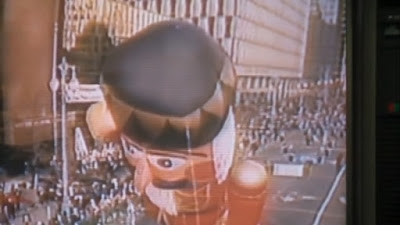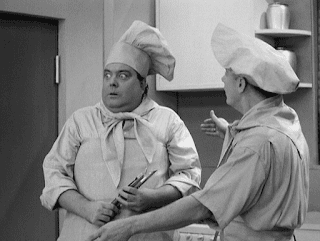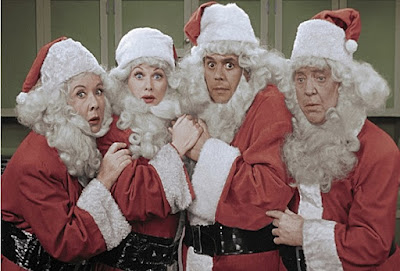For my real job, I hardly ever get to work with the same people more than once. We often ask each other the same standard "get-to-know-you" questions to make awkward small talk as we sit together in an "office" the size of a public restroom toilet stall. Hopefully, answering one of these "safe" questions will spark more conversation. One of the more common questions is about movies and actors.
In one of my "Character Actor" articles (which you can find in the Collections Tab), I described how I don't really have a favorite actor or actress; instead, I'm fascinated with character actors. By definition (according to Wikipedia anyway), a character actor is a supporting cast member who plays unusual, engaging, eccentric, or memorable supporting roles.
For example, perhaps you're watching something on television and see a background actor or a supporting character and go, "Hey, that guy played so-and-so in..." Well, THAT's a character actor. For sports fans, think of them as the versatile utility players of Hollywood.
I'll often annoy my wife with commentary like, "Hey, that person was also in (fill in the blank.)" Sometimes, my need to know where I've seen them before is so great I'll pause what we're watching and Google them until I'm satisfied that I've figured out where I've recognized them from. I've noticed over the years that she's caught that same bug and will frequently out-google me!
One of my favorite character actors may not be a household name, but I guarantee everyone knows precisely who he is from his face. He frequently plays someone with a gruff, to-the-point, somewhat sleazy, old-school New York attitude. It's not surprising that he's a favorite when I think about it.
His facial features were unique enough to be immediately recognizable but not off-putting. He was short, rough around the edges, and I'd say ruggedly handsome, although he wouldn't win any People's Magazine Sexiest Man contests. More often than not, though, he played the slick-talking wise guy or grumpy old curmudgeon. He's a Hollywood legend and the epitome of what he himself called "the beleaguered everyman."
He's THAT GUY... Dick Miller.
As a supporting actor, his presence graced numerous classics (and many not-at-all classics), no matter how small his role was. He always gave a memorable performance, and at times, his scene was more memorable than the rest of the film. It's not a small feat that a small-part actor leaves such a mark on the entire industry.
Miller just seemed likable, no matter the character. There was something redeeming about him, whether he played a hired hit guy, a sleazy used-car salesman, or a murderous hipster. Despite whatever shortcomings the character, or the real-life man, had, you began to care about both of them through his exceptional acting abilities.
He was born Richard "Dick" Miller on Christmas Day in 1928 to Russian-Jewish immigrants Ira and Rita. Ira was a printer of books and magazines, and Rita was an opera singer. His early life makes him appear to be truly the perfect tough guy. Despite being underage, in 1945, he signed up for the Navy, lying about his age so he could go fight in World War II. The war had been fought and won before Miller saw much fighting, but he distinguished himself as a middleweight boxer during the rest of his tour of duty.
After his time in the Navy, he attended the City College of New York and Columbia University. To make ends meet, Miller took jobs in the medical field as he started to perform on Broadway. The internet proclaims that he earned a PhD in Psychology, but as best as I can tell, that was only a joke that Miller once told since one of his odd jobs was working at the infamous Bellevue Hospital in New York.
His first breakthrough beyond small parts on Broadway came in 1950 when he cohosted the television show "Midnight Snack" with Bobby Sherwood. Today, the show is regarded as potentially the first late-night television talk show. In 1952, Miller moved to California looking for work as a movie writer.
Once in California, he quickly made friends with Jonathan Haze, an actor who had been in a few films made by the then brand-new but now legendary director Roger Corman. Corman was a newcomer to producing and directing, then exclusively involved in making low-budget schlocky horror movies for the drive-in theater crowd. In any event, Corman produced Haze's acting debut in "Monster from the Ocean Floor" in 1954, and Haze proceeded to be in every Corman film after that, no matter how small the part.
Corman claims he spotted Dick Miller's potential immediately, and he made him a member of his regular ensemble quite quickly.
Miller's on-screen role occurred in 1955 in his debut film "Apache Woman," directed and produced by Roger Corman. He played a hat-wearing Native American called "Tall Tree," a somewhat inside joke about Miller's height. He also played a second part in the same film as a member of the posse of cowboys who battled with the Native Americans. Miller later joked that one of his characters shot his other character in the film. This might even be true, to be fair. I haven't seen this particular movie, but playing two characters at the same time was pretty common in the cheaply-made films of the era.
"Apache Woman" was his first Corman film, but it was far from the last. Miller joked that Corman liked to use him because he was always out of work and available, but Corman insists it was because he brought a real sense of personality to even the most generic of roles. Miller appeared in Corman's other films made in 1956, "The Oklahoma Woman," "Gunslingers," and "It Conquered the World."
 |
| Miller as the vacuum salesman in 1957's "Not of this Earth" |
In 1957, Corman cast Miller as a vacuum cleaner salesman in "Not of this Earth." Miller's performance in this film finally turned the corner on his career in Hollywood. While his scene wasn't any more integral to the plot than his past film, he demonstrated his uncanny ability to turn a pointless scene into his own and leave a lasting impression.
The film itself was pretty lame; a B-movie about an alien that harvested blood from unsuspecting citizens of Southern California to save the population of his dying planet. In one screenplay draft, a brush salesman was supposed to turn up at the door to the home of the human-looking alien and meet his inevitable gruesome end. When Miller got the part, he changed the sales item from brushes to a vacuum cleaner (thinking it was funnier to say). He ended up ad-libbing his entire dialogue to seem like he was not just a one-dimensional salesman - but a conman on the take. Miller's actions resulted in a hilarious scene-stealing role that demonstrated his quirky personality, which would become the signature of his career.
As a result of his performance in "Not of this Earth," Miller's roles grew gradually bigger in his subsequent Corman features. In 1957 and 58, he appeared in "Naked Paradise," "Carnival Rock," "The Undead," "Rock All Night," "Sorority Girl," and "War of the Satellites."
Dick Miller's first leading role in a film came along in 1959 in Roger Corman's "A Bucket of Blood." Miller played a wannabe sculptor named Walter Paisley, who suddenly earned fame in his small artsy beatnik circle with the skills to make highly realistic works of art. Unbeknownst to his friends, his masterpieces were actually his murder victims covered in clay.
Miller, the quick-witted, fast-talking New Yorker that he was, was perfect for the comedy aspects of the film. Despite being the villain, Miller's stardom shined brightly. Bucket of Blood was never going to win "Best Picture." Still, it's an enjoyable horror comedy that, just from researching this article, I've discovered, has gained a powerful fan following. Despite being the leading man, and the following the film itself has, "A Bucket of Blood" did not lead to more starring roles for Dick Miller.
The name Walter Paisley from "A Bucket of Blood" would follow Dick Miller around for the rest of his career. He would be called Walter Paisley in nearly ten more films, any time a name was needed for a small-time character as an homage to his role in "Bucket." After the first instance, he would again most notably play Walter Paisley - this time a talent agent - in "Hollywood Boulevard," a film directed by Allan Arkush and Joe Dante. Dante would again cast Miller as Walter Paisley in the 1981 film "The Howling" as the owner of an occult bookshop. Two years later, the name would pop up again with Miller as the owner of a diner in "Twilight Zone: The Movie." "Chopping Mall" saw a janitor named Walter Paisley, and the 1994 made-for-TV remake of "Shake, Rattle, and Rock!" had Miller play a police officer named... Officer Walter Paisley.
 |
| Miller in 1960's Little Shop of Horrors |
Miller's next film is another Roger Corman film and one of pop culture legends. "Little Shop of Horrors" was filmed back-to-back with "A Bucket of Blood," and according to Hollywood legend, it was shot in only two days. Dick Miller was offered the leading role but turned it down, considering it to be too close to the character he played in "A Bucket of Blood." Miller suggested his friend Jonathan Haze, who wound up being just perfect for the role of Seymour Krelbrorn, the florist who, by chance, discovers a rare plant that makes him rich and famous. Unfortunately, that plant eats humans, and Seymour begins killing people to feed it. In later years, Miller would lament passing on the role, but the part that Dick Miller did wind up playing (a flower-eating man) supplied the movie with some of its biggest laughs.
What makes the movie so unique, and partly why it was popular enough to be remade in 1986 (the version most people remember today), was the scene-stealing appearances from the Corman film regulars. Dick Miller, of course, steals his scene eating flowers, but it's Jack Nicholson, yes, THE Jack Nicholson, in a hilarious scene as a masochistic dental patient that is one of the most memorable.
Dick Miller worked off and on with Corman throughout the 1960s and worked alongside some Holywood legends like Peter Fonda, Francis Ford Coppola, and Jack Nicholson. In the 1963 film "X: The Man with X-Ray Eyes," Miller worked alongside legendary comic Don Rickles as a carnival heckler. In it, Dick desperately attempted to explain the plot of "The Terror" to co-star Jack Nicholson in a downright show-stealing monologue.
Miller would appear in the classic film "The Dirty Dozen" in 1967 but had such a small part his name wasn't even listed in the credits. During the late '60s, he appeared in many beach party or ski-bunny type movies, with titles such as "The Girls on the Beach," "Ski Party," and "Beach Ball," all of them harmless teen films with thin plots and musical numbers.
Also in 1967, Miller would appear in a western film called "A Time for Killing," starring Inger Stevens and Glenn Ford. The movie itself isn't anything to write home about, except that Miller worked alongside a very young Harrison Ford.
The early 1970s brought more of the same to his career. While he began writing a handful of screenplays like he intended to do nearly 20 years prior, he continued acting for Roger Corman's new production company, New World. He appeared in numerous erotic comedy flicks, like "Night Call Nurses" and "Fly Me." These films were just low-budget junk, but it was work.
Eventually, New World (and Miller's) films improved slightly, with the gangster film Big Bad Mama starring William Shatner and Angie Dickinson. Bloody Mama, another notable notch on Miller's work belt, starred Shelley Winters and a young Robert de Niro.
By the mid-1970s, Dick Miller had been typecast by the big movie studios as a B-movie actor. He'd been in countless feature films by that point, but his career was fairly stagnant. Then, in the late 70s, a new breed of directors began to take over Hollywood. These directors grew up on schlocky horror films and remembered Dick Miller's outstanding performances and his familiar face.
The first of these directors that called Dick Miller for a job was Jonathan Kaplan, who cast Miller from the mid-70s onward. Still, his real "rediscovery" (if you can even call it that) was when Joe Dante (in his directorial debut) and Allan Arkush filmed "Hollywood Boulevard."
"Hollywould Boulevard" was a silly satire of the world of low-budget B-movie production in which the cast of one such film is killed off one by one by a masked killer. Filled with many inside references, perhaps the funniest one (for Miller) came when he was cast as "Walter Paisley," the sleazy agent of the lead character.
Dante was a fan from childhood and very pleased after working with Miller in "Boulevard," and would go on to cast him in each and every one of his feature films since then. In "Piranha," Miller played a slimeball water park owner not especially concerned with reports of a deadly piranha headed his way. He played the owner of an occult bookstore that was knowledgeable about werewolf lore in "The Howling" and played a cook in a greasy-spoon diner in "Twilight Zone: The Movie."
Most famously, Joe Dante cast Miller in 1984's "The Gremlins" as Mr. Futterman, a snowplow driver who seems to meet an ugly end at the hands of the Gremlins. Don't worry, he'd be back as Mr. Futterman in "Gremlins 2: The New Batch" in 1990.
Dante cast Miller as a policeman in "Explorers" and a cab driver in "Innerspace," in 1985 and 1987, respectively. Joe Dante cast him again as a wisecracking ventriloquist in "Amazon Women on the Moon" in 1987, but his scene was cut for time.
In 1989, he played a garbageman in "The Burbs," an excellent dark comedy starring Tom Hanks.
 |
| Dick Miller as Herb Denning in 1993's Matinee |
In 1993, he was cast as a former B-movie actor and is now hired as a promotional agitator for a schlock horror film director in one of my all-time favorite films, Matinee. It's an homage to science fiction double features and "kiddie matinees" from the 1950s, starring John Goodman as the filmmaker Lawrence Woolsey, based on real-life filmmaker William Castle. Please CLICK HERE to read more about this great film.
 |
| In "Matinee," Gene discovers why the protestor (Miller as Herb Denning) looked so familiar |
Although Corman and Dante were his most frequent collaborators, Miller worked with several notable filmmakers. He worked with Martin Scorsese on "New York, New York" in 1977, opposite names you may know, like Robert De Niro and Liza Minelli. In Scorsese's "After Hours," Miller gets to deliver the film's tagline, "Different rules apply when it gets this late. You know what I mean? It's like after hours!"
Miller would work with Robert Zemeckis on "I Wanna Hold Your Hand" and "Used Cars," as well as Steven Spielberg on "1941."
Miller also famously had brief but stand-out scenes in "Rock n Roll High School" in 1979 as the police chief trying to come to terms with the rock band The Ramones, with the famous line "They're ugly. Ugly, ugly people!"
He also appeared in the classic 1984 film "The Terminator" as a chatty gunshop owner who gets blown away by Arnold Schwarzenegger.
Dick Miller was also included in a movie made by the master of old film references, Quentin Tarantino, but due to the length of the feature, his scenes were cut. That movie was "Pulp Fiction," and I can just imagine how perfect Miller would have been. Shame.
Miller continued steady work, with a bountiful list of credits between these more prominent films. None of them are classics, but they are all livened up by his performances... and many of them needed a lively performance if you catch my drift.
A character actor like Dick Miller was also perfectly made for television, his natural charisma making up for the lack of backstory that is often disregarded with background and supporting actors.
 |
| Miller as "Vin" in Star Trek: Deep Space Nine |
He's appeared on television since the late 50s in series like Dragnet, Dragnet 1967, Bonanza, Wagon Train, Combat, Soap, Taxi Untouchables, Police Woman, Moonlighting, Who's The Boss, General Hospital NYPD Blue, and E.R. After having a career resurgence thanks to "Gremlins," Miller would be cast in more prominent roles in bigger name shows like Tales from the Darkside, Miami Vice, Star Trek: The Next Generation, Star Trek: Deep Space Nine, and Lois and Clark: The New Adventures of Superman.
Miller even had recurring roles in two television series: Fame, a spin-off of the dance movie of the same name, and Flash, a very short-lived series based on the comic book.
As the 2000s rolled around, Dick Miller slowed down a bit, given that he was already 71 years old. He continued to work, giving off vibes of a slightly corrupt but immensely likable every-man.
Somewhere amidst all this, Miller married his wife Lainie (Sheila Elaine Halpern) in October of 1959. They had one child together, Barbara. Unfortunately, on January 30, 2019, Dick Miller passed away from a heart attack while being treated for pneumonia in Toluca Lake, Los Angeles. He was 89.
A 2014 documentary, literally titled "That Guy Dick Miller," was released highlighting his life. It's still available today if you dig enough online, and it does a beautiful job of letting him and his friends tell the story of his life and career. It's a little hard to follow sometimes; the low budget and unnecessarily brightly colored comic book-esque on-screen effects were distracting, but the meat and potatoes are there. With audio and video, they do a much better job describing Dick Miller and his career than I ever could here on this site with the written word.
There's also a biography titled "You Don't Know Me, But You Love ME: The Lives of Dick Miller" by Caelum Vatnsdal, but it's hard to come by, and I haven't read it yet. It's credited as being exhaustively detailed, especially during his early years.
Dick Miller may have never gotten the leading role. Yet he developed a large and loyal following over the years from generations of movie fans who responded to his distinctive looks, his innate ability to steal a scene from anyone, or his gruff, slimeball-nice guy act. He was a true favorite of mine, and I hope this little tribute did his career justice.








.png)





Comments